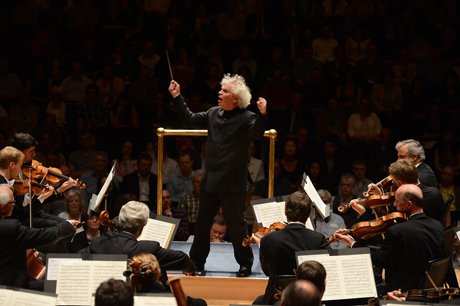Vienna Philharmonic / Sir Simon Rattle – review

The Vienna Philharmonic Orchestra perform music by Brahms, Webern and Schumann conducted by Sir Simon Rattle at the Barbican on Sunday, 17 June 2012. Photograph: Mark Allan.
The closing night of the Barbican’s lavish ‘Great Performers’ season saw British export Sir Simon Rattle, shepherd of Europe’s esteemed classical institutions, return with the Vienna Philharmonic in tow.
On offer were third symphonies from master and disciple, Schumann and Brahms, interspersed with an atonal offering from Anton Webern.
The symphonies, both infectiously jovial, both inspired by the Rhineland and both commenting on the woman that came between the two men, Schumann’s wife Clara, are absorbing in their juxtaposition.
The Vienna Philharmonic has an historical association to the Brahms, having premiered the work in the Austrian capital back in 1883 under legendary conductor Hans Richter.
Brahms is most exciting when played irreverently, emphasising the German’s natural buoyancy, a strategy adopted by Rattle in this youthful interpretation, which emphasised the mood of the three-note, ‘frei aber froh’ (free but happy) motto that pervades the opening movement.
Giving Brahms space to breath forced Rattle to loosen his usually tight rein on the orchestration, and the evening was shaped less by the conductor’s famously energetic interpretations, and more by a focus on the elemental echoes within the three compositions.
Just 26 years separate the Brahms, written in 1883, and Webern’s Six Pieces for Orchestra, first penned in 1909, but the two are epochs apart in tonality and theme.
Webern’s short, funereal exploration offered a stark contrast to the high-spirited Schumann, awakening the audience to the constraints of the canonical nineteenth-century composers.
This was not vintage Sir Simon, but a refreshing reminder of why this trio of works are worthy of being constantly revisited.
Vienna Philharmonic / Sir Simon Rattle
Music by Brahms, Webern and Schumann
17 June 2012
Barbican Hall
